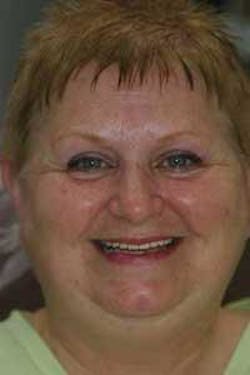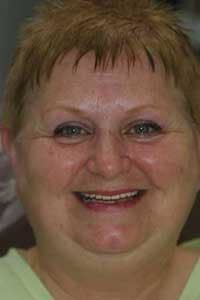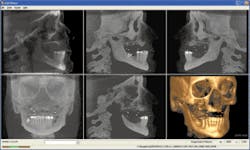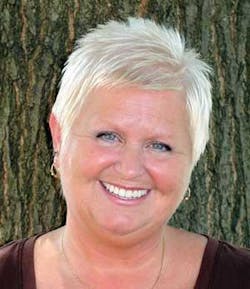3-D Case Study: From Dental Disability to Extraordinary Dental Health
Glenn J. Wolfinger, DMD, FACP
Thomas J. Balshi, DDS, FACP
Patient profile
A 52-year-old female presented to Pi Dental Center in Fort Washington, Penn., with no upper teeth and missing lower back teeth. The patient had been fully edentulous in the maxilla for 22 years, which resulted in significant maxillary bone loss. The missing mandibular posterior teeth made it difficult for her to function. The patient desired improved function, comfort, and esthetics. Her medical history of diabetes, sinus trouble, and stomach disorders were all significant factors in her treatment planning.
null
Clinical exam
Following a thorough oral exam that included an assessment of the existing prosthetics, photos, diagnostic casts, intraoral radiographic series, panoramic, and AP and lateral cephalometric radiographs, the following treatment plan was developed:
- Fabrication of new maxillary complete denture and a mandibular complete immediate denture
- Extraction of the remaining mandibular anterior teeth to allow the placement of five implants for a full mandibular Teeth In A Day™ implant reconstruction (www.ofspirit.com/lucyferreria1.htm)
- Placement of radiographic gutta-percha markers in the maxillary complete denture for 3-D i-CAT (Imaging Sciences International, Hatfield, Pa.) scanning and Procera (Nobel Biocare, Yorba Linda, Calif.) conversion purposes
- Procera planning for ideal implant positions in the maxilla
- Fabrication of custom surgical guide for placement of the implants in the maxilla
- Planning for free-hand zygoma implant placement to provide support in the maxillary posterior where there is an inadequate volume of bone for standard implants.
Radiographic study
Following a 20-second scan, the i-CATVision scan data (in DICOM format) was imported into Nobel Biocare Procera software for further 3-D implant planning. Evaluation confirmed the inadequate volume of bone in the maxillary posterior and the need for zygomatic implants. While the thin maxillary anterior alveolar ridge would have been a significant challenge using the free-hand surgical approach, the 3-D images confirmed adequate bone volume for the precision-guided placement of anterior implants. Adequate bone volume was realized in the pterygomaxillary area where additional implants were placed for optimum posterior support. Clear 3-D orientation for the placement of zygomatic implants was reviewed prior to the procedure.
null
Clinical course
Complete dentures were fabricated in the in-house clinical lab and the mandibular immediate complete denture was converted chair side using the Teeth In A Day™ protocol. After the maxillary scanning and planning, five implants were precisely placed using NobelGuide (surgical guide), in a non-invasive flapless procedure. Two additional zygomatic implants were then placed, incorporating the knowledge of the 3-D imaging. After three months of functioning with the all-acrylic fixed implant provisional restorations, the final implant restorations were delivered. The final upper is a CM Bridge Ceramic and the lower is a CM Bridge Acrylic, (CM Ceramics, Mahwah, N.J., www.maloceramics.com/en/Mahwah.aspx), and both arches are supported by titanium framework. The patient is very excited with the esthetics and functional results of her new smile, which has restored her self-confidence. Her fixed teeth have helped her significantly in the process of becoming a certified scuba diver.
null
null
Glenn J. Wolfinger, DMD, FACP
Dr. Glenn Wolfinger is a board-certified prosthodontist practicing at Prosthodontics Intermedica in Fort Washington, Pa. He is a fellow of the American College of Prosthodontists and the Academy of Osseointegration. Dr. Wolfinger graduated from Tufts University School of Dental Medicine and completed a residency in combined prosthodontics through the VA-Harvard Program in Boston. He is currently a member of the adjunct faculty at Nova Southeastern University and co-director of the Institute for Facial Esthetics. Dr. Wolfinger is a past president of the Pennsylvania Prosthodontic Association, and a member of numerous other dental organizations. He has participated in critical research projects, lectured internationally, and had many articles published in peer-reviewed journals.
Dr. Thomas J. Balshi
Dr. Thomas J. Balshi is a board-certified prosthodontist and founder of Prosthodontics Intermedica in Fort Washington, Pa. He is also the director of the Institute for Facial Esthetics. Both his graduate and postgraduate degrees are from Temple University School of Dentistry. Dr. Balshi received his surgical and prosthetic implant training from Professor Per Ingvar Brånemark, Institute for Applied Biotechnology, at the University of Toronto in 1984 and in Götenborg, Sweden. He is a diplomate of the American Board of Prosthodontics, a charter member and fellow of the Academy of Osseointegration, a fellow of the American College of Prosthodontists, and a fellow of the American Academy of Implant Prosthodontists. Dr. Balshi is a distinguished practitioner in the National Academies of Practice, and a member of the International College of Prosthodontists, the American Society of Geriatric Dentistry, the American Dental Association, and the Delaware Valley Academy of Osseointegration. He was a founder and president of the Pennsylvania Prosthodontic Association. He lectures globally and has published numerous scientific articles and videos on the subject of Brånemark implants and immediate function. Dr. Balshi coauthored a textbook titled A Patient’s Guide to Dental Implants.






